Of course, most of his time the dachots are given to vegetable and fruit plants, hoping to get a rich harvest. But I want to surround yourself also with beauty - those plants whose bloom raises the mood! And if there is no possibility in order to pay a lot of attention to colors, then you can surround yourself with natural lyplines - very beautiful and unpretentious. Do you want originality and diversity? Then choose the taste of the hybrid loyal grade.
General information about Lily
Lilyniki is grassy rhizable perennial plants attributed to the family of xanutorreum. Eastern Asia consider their homeland. People familiar with these plants for a long time, but the scientific name of Gemerokalles came up with the famous Systematics of Plant Flora Karl Linney in 1753. He connected together two Greek words: "Hemera" and "Callos", which is translated, respectively, "day" and "beauty." Russian people are so called these plants with beauty. The dropped flower in the elegant inflorescence of the Lily Lily lives only day, day, showing his beauty. Then he fades. At the same time, two (or more) flower is revealed at once.
In Lilyniki, fleshy, thick appling roots, in the form of cords-shaped. Thanks to them, plants are capable of carrying a drought normally. Burnt leaves in hemierokalles stand straight or most often a densely curved. Placed in two rows, in the form of broadline. Wild species flowers most often yellow, orange or reddish-brownish shades. It is easiest to grow natural species, such as the Lily of the Redhead, Yellow, Lemon-Yellow, Middaddorf, Duchortier, Forrest.
They are unpretentious, well tolerate the "extremes" of weather - drought or long rains, rarely sick, their pests are bothering little. In the 30s of the last century, after a successful crossing of the botany and enthusiasts of these plants of these plants taken from nature, new varieties began to appear, united in a large group of hybrid loyers.
The famous specialist in the Lily, Belgian Francois Verhaart believes that there is no easier classes than crossing the Lilynikov. In the zones with a warm climate from the moment of receiving seeds to blooming the seedlings grown of them take less than a year. The technology of breeding works is not relieved, so lovers of Lilynikov annually create a huge number of amazing varieties, now their number has already exceeded 80,000.
From the history of the appearance of loyal hybrids
The very first hybrid hemroalkalles were created by Flower from England Perry Amos and another admirer of Krasolovnevov - American botany Stoyt Arlow. And it happened at the end of the 20s of the 20th century. Until the 60s, it was possible to remove only copies, the color of the flowers in which was orange-yellow or reddish-drone (for example, the famous variety of Bonanza). Much later appeared specimens with lilac, pink and purple petals, their form was narrow and pointed. For example, the popular and now grade "Katerina Woodberry", giving pinkish-lilac flowers. At first, all hybrids were diploids, and after the 70s, tetraploids arose - varieties with double chromosomal set. Petals for such plants began to get wider and brighter in color. For example, such amazing varieties were born as:
- "Strawberry Lollipop" (a lot of awards, forming strawberry-colored flowers, transfusions due to the "diamond" spraying);
- "Joan Senor" (considered one of the best copies that form white flowers).
In 1988, the public was presented with a wonderful variety with a corrugated sideline on the petals - "Idas Magic" (translated as "Magic Ida"). Created him Bill Manson and gave him such a name in honor of his mother Ida. Then there was a whole series of varieties with corrugated. Now many breeders are aimed at work in two directions:
- The creation of plants, the form of flowers in which there will be a spider-shaped, with long petals, so they got the name "Spiders". Breeders want to get giant sizes flowers - from 15 to 30 centimeters.
- Remove plants with terry flowers (Double Group). But such plants will require greater attention from gardeners, greater care, otherwise the flowers will not justify the hopes, it turns out unpleasant.
A variety of hybrid Lilynikov
The hybrids have a powerful root system that allows them to transfer arid periods. The dark-green leaves have an oblong shape, their tips are a little bent down. There are leaves fan-like. The height of hybrid lyplifers ranges from 50 to 120 centimeters. One hybrid bush can bloom from three weeks to three months, it all depends on how many color lines on the plant, in what conditions it is contained. Most daily daytime, their flower is open in the morning, closer to the night fades. But there are such that reveal the flowers closer in the evening, and their wilt occurs in a day. Briefly call those hemierocalles that keep the flower to 24 hours.
In some Lilynikov, for winter, the leaves die off (they are called sleeping), others can be found in the first-eavennese (transitional), and third in the warm winters all leaves are stored unchanged.
In general, hybrids are classified by different signs, for example:
- altitude;
- flower shape;
- coloring;
- sizes of the opened flower;
- aroma (its presence or absence);
- type of vegetation;
- flowering timing.
The height of the hybrids is classified on:
- high (more than 80 centimeters);
- medium ("Growth" in the range from 60 to 80 centimeters);
- low (from 30 to 60 centimeters);
- dwarf (their sprouts are less than 30 centimeters).
Under the blossom period, researchers share Krasdrenov on:
- very early blooming (these are Milford Lilyniki, Duchiyat and varieties, from them received);
- early (on them flowers appear in the last days of June and make beauty to the pastry of summer);
- the average (their overwhelming majority, reveal the flowers from mid-July and until August 15);
- late (on them bloom begins from the middle of the last month of summer and continues in September);
- repair (capable of blooming re-by the end of September).
The fragrances are obtained by those varieties, when creating odorless wild species, this is predominantly Lily Middaddorf or Yellow. Then in the catalog about the grade there is the designation - "FR".
The form of the flower is Krasdrenov, can be:
- funnelid;
- round;
- flat;
- bent (the tips of their petals are strongly twisted, as if curls, outward);
- triangular;
- wheelchair;
- spideroid (these are spiders);
- orchidoid;
- lace, corrugated (petals are decorated with cloths, rags, rushes, fringe, for their expressive descriptions are even used by the terms, for example, "the wings of an angel", "the teeth of the shark", "Sovie ears", "Popcorn");
- indefinite shape (informal).
Separately, I want to tell about the terry Lily. They have more than 6 petals. And here is a variety of types:
- pionic (with petaloids in the central part) and "flower in a flower" - three circular row of petals;
- star-shaped (with narrow petals);
- tubular (flower diameter less than its length);
- multi-treatments - they have 2 rows of petals, but at the same time there are not 3 petals in each circle, and 4 or even 5;
- unusual - with twisted, shovels, squeezed petals, with the growing up on them, as if the "beard".
Terry flowers are obtained at varieties:
- Sanbarst (painting of honey-brown flowers, their petals are as if twisted);
- "Highland Lord" (round flowers with wide petals like a velvet structure, their color is dark red, saturated);
- "Double Red Royal" (in flowers large sizes, dark red color, inside the petal smaller than outside);
- "Double Dream" (the flower inner part is dark orange, and apricot petals, its diameter is about 12 centimeters);
- "Longfields Doubleelicious" (brick-orange flowers having a yellow "neck", their diameter of about 15 centimeters).
On the color of classifications a lot, we give only the main groups:
- yellow, golden;
- apricot and melons;
- orange;
- pink;
- pastel;
- lavender, lilac (although in catalogs sometimes mean them as blue or blue);
- purple (here are attributed and purple);
- brown;
- very dark (in fact they are dark purple or dark-red, although they may seem black);
- white (it would be more correct to write "almost white", because they are with the presence of pleasant yellowness or light pink, purely white has not yet been derived).
In the color of the flower of the hybrid leafer can be not only monochrome (monotonous), but also:
- mixed (when the transition of one tone in another is observed), the innermost (neck) can be painted in another color;
- two-tons (vividly expressed intensity of one color);
- two-color (external and median petals are equally different in color);
- contrasting, pedestrous;
- with the presence of "eyes" (in the design of the flower drawing);
- with the presence of "hoop" (has a similarity with the "eye", but can only be traced on the inner petals);
- with the presence of "watermarks";
- with the middle line on the petals;
- with boring;
- with specks, arrows, strokes, with "droplets".
Several interesting varieties of hybrid Lilynikov:
- "Stella to Oro" - the abundant all summer season is leafy-free radical, who received many awards. The flowers are a funnel shape, they are fragrant, gentle, with corrugated dark-yellow petals.
- Romantic Rose is a longtime variety forming low (up to 40 centimeters), but abundantly flowing bushes. Fragrant flowers are disclosed in the morning, their painting in pink-apricot and coral colors. A light line is noticeable on the outer petals.
- "Granny Smith" - the flowers are almost white, a green cutter goes on the edge of the corrugated petal.
- "Ruffled Parchment" - a flower creamy-white corrugated petals, in the center (this is "Gorlashko") the coloring goes into a yellowish. The size of such fragrant flowers is about 13 centimeters.
- "CHANCE ENCOUNTER" - refers to a long-lying, large (diameter of 15 centimeters) fragrant flower remains opened about 24 hours. Petals in the raspberry-pink flower, their edge is golden, and the inner inner inner a green flower. The variety for many years shows winter hardiness, its leaves die in the fall.
- "Gadsden Firefly" - very winter films, blooms early, its height is 85 centimeters. Flowers fragrant, diameter within 9 centimeters, color copper-golden.
- Congo Coral - in mid-July on this bush, whose height is 45-55 centimeters, terry large flowers (their diameter 15 centimeters), painted in coral and pink colors, are beginning to be revealed, painted in coral and pink colors, there are red "eyes", and the innermost of the greenish flower Yellow.
- "Burgundy love" - \u200b\u200bat the end of July, on this bush, whose height does not exceed 55 centimeters, you will see the spectacular red-burgundy flowers, the "neck" of which yellow-green. They are terry, size within 14 centimeters.
- "CRIMSON PIRATE" - at the end of July, a large (up to 15 centimeters) bright red flowers, their "neck" is a yellow, and dark red halles are revealed on the colorhouses reaching the height of 60-80 centimeters.
- "Helix" - the removable bush gives giant spiders flowers, the "neck" of the green flower is gradually moving into yellow petals, and their tackets are dark crimson.
- "Free Hiling" - also the repairing bush forming large long-bearing spiders, the "neck" of which is saturated red, and the petals of cream-yellow color.
Important nuances that need to be considered when selecting those or other leafers for the garden:
- Be sure to pay attention to which group according to the peculiarities of the growing season. Many luxury loyers (for example, corrugated) are evergreen or natives. If you live in those regions where winter are with frosts, they will certainly need to be carefully stolen.
- If you have a desire to have unpretentious flowers on the site so that later they do not require special care, then acquire species hemierokalles or varieties derived for a long time and time-tested. These include "Jordan", "Katerina Woodberry".
- If you are a beginner flower and previously not grown Lilyniki, it is better to start with simple species plants or simple, inexpensive varieties.
- The success of growing and beautiful flowering depends on the landing material. If these are Delinki, then all signs of varieties are transmitted from the parent plant. But a new method of reproduction using a culture of tissue, called clonal microdistrict, has not yet achieved perfection, so the offspring often there are significant deviations. For example, deformed flowers are formed, they may not be disclosed at all, have a glittering color and a weakly expressed pattern.
- If you bought Delinki, who already have big sprouts, then they will have to temporarily put them in the container (or pot) for rearing. Then you transport your plants to the cottage.
Take a landing of hybrid loyers
When choosing a place for hybrid Lilyiniks, preference gives the gardens zones that are well lit by the sun at least six hours a day. In the southern regions with the scorching sun, the hybrids must be placed in the shadow or half. Old varieties and those that give dark-painted flowers, also place in the half. The soil for these plants is needed fertile, because they for a long time (10-15 years) will develop in one place. If the soil on your dacha is hard, then first improve it by adding river sand, overwhelmed with a ripe compost.
If you have, on the contrary, sandstones, then with a peopling, make loam or clay, reworked korovak or horse manure, add a ripe compost.
Now we will deal with the acidity of the soil layer. It is best to suit neutral or weakly acidic soils. Therefore, if the soil is very screamed, it is possible to change the reaction of the medium with ash or dolomite flour. In soils with an alkaline reaction medium, pre-make an acidic peat.
On the dend (segment of the root) there must be several points of growth and root.
A pit for any defense, even if it is very small, make a depth and diameter of 50 centimeters. In the future, you will fill it with a fertile substrate. First, make a "holmik", wilsh it well. Wait for the water to absorb, then straighten the roots of the deceive and fill in the pit so that the root neck is to be flown with the surface of the soil or slightly opened (no more than two centimeters). Soil sniffing slightly. If you segments of the root of you are somewhat, then between them certainly leave a distance of 50 or more centimeters, because bushes will grow. To enrich the soil with nutritional elements, enter when landing to the substrate "Kemir-Universal" (if the landing work spend in spring time). If you do it at the beginning of autumn, you can add "Kemir Autumn".
How to care for hybrid lyplines?
- Watering. The water is loved by the water, but they have powerful, thick roots, so they can feel quite normal for several days without water. And when you wipe them (one or twice a week, preferably in the morning or evening hours), then they put water in thickening on the roots. "Poll" the plants abundantly, their roots deeply go into the crowd of the soil layer and are strongly branched. But it is immediately warful that the soil under young plants so that they quickly adapted in your garden and have taken root, it is necessary to moisturize more often.
- Mulching - they will suit him the chopped pine core, beveled grass, coniferous opead either peat. Mulch layer in six centimeters will hold moisture in the ground, reduce the amount of weeding herbs around, prevents strong heating of the Earth in hot days.
- Feeding. In the first season, hybrids do not need feeding, because when landing you provided them with fertile land. In the following seasons, fueling the bushes as follows:
- in May, the greenery is needed by the green mass of the urea;
- in June, plants are preparing to give buds and flowers, so at irrigation, mineral complexes can be added, for example, known to all "Kemir";
- after bright flowering, the hemierokalles rest a bit, and then begin to lay the flower kidneys to re-please the flowers next year. During this period of life for plants, it is better to prefer phosphorus-potash mixtures or take "Kemiru Autumn".
- Do not forget that throughout the season it is necessary to maintain a preferred soil medium reaction, adding to water for watering and stirring the dolomite flour or a little citric acid there (or slumbering sour peat).
- So that Krasodnev's bushes always looked well-groomed and tidy, cut off those inflorescences where the flowers have already shown their beauty and faded. If you don't need the seeds, then cutting and those blooms on which immature boxes appeared with seeds.
- Serious harm can be driven by hemierocalles tryps. First, they rise through the stems and suck the juice from the sheet plates, and then they are inlets into the boutons and fly there. Wintering these pests near the roots, descending into the soil. If you notice the permit of the TRIPS, then it is recommended to cut out that bloomout near the ground, on which the flowers are damaged and burned. Approach similarly with deformed leaves. In the spring and late autumn, the soil under the bushes can be treated by using the drug "Inta-Vir" (or newer means).
- Another pest capable of spoiling a beauty of a hybrid flower is a Lily Komarik. His adult individuals lay eggs directly into boutons. When the larvae appear ones, they feed with juicy content of bud. Then the bud looks underdeveloped, pale, curved. Such buds will have to delete and burn.
- If there are mute rodents, referred to as waterfronts, then they can ruthlessly shrink the rhizomes of Krasodnev. Fighting with gagwesters, spill bulbs, dackets are also trying to the extermination of rodents.
- In the invasion, the bushes immediately need to spray "accutelle". But in a rainy summer, when slippers are fruitful, they will have to fight with them in different ways, including all sorts of traps, sprinkling the earth ashes, spraying plants with infant of the tomatoes steps.
- Transfer. It is engaged in several cases:
- when the bush rumbles badly or he has more than ten years;
- when you like the variety, and you want to multiply it in your site or give familiar, colleagues for work, friends;
- when another floral composition came up and want to embody her in reality.
So, it is necessary to deal with the transplant or in the spring when Kraswodenev just went into growth, or in September. Carefully dig a plant, smooth with the roots of the earth and inspect them. Damaged parts of the root system and the fallen roots immediately delete. And leave a bushing for some time in the shade. If you are engaged in this fall, then leaves do trin, leaving 12 centimeters of the stem. Divide the chopping and "add" the delinks to the new garden places or pass into the ribbed hands.
Fighting root rot
Sometimes the roots of these beautiful plants are damaged by rot. They indicate the following signs:
- In the spring, the Krasdrenove is rushed into growth, and at some bushes this growth suddenly stops. And those leaves that have already grown, suddenly yellow, become fragile, break.
- If you try to pull the leaf of the loyal, then it quickly pulls out of the soil.
How to save the sick bushes? First dig and inspect the roots. Cut those parts that are amazed by rot. Then thoroughly rinse them in a solution of manganese (make it pink). Places where the cuts were made with a knife, treat a fungicidal preparation. Spread the roots for two days so that they are good. Then these roots can be planted. Only place. Choose another away from the previous one. After some time, the young shoots of Gemerokalles will begin to grow from the "sleeping" kidneys.
Zimovka Lilynikov
Many hybrid varieties are sleeping in winter, they are winter-hardy. Therefore, they can not be covered in addition, they will have enough natural "snow blanket". But in order to accurately be sure that your favorite varieties or very young bushes will be well thrown away, some of the gardeners still covers the planting of the plant. Cutting leaves can be made at the end of autumn or with the arrival of spring.
Special troubles are not delivered, but beauty and positive emotions give a lot. Dachnikov, harmonious compositions are obtained if they accommodate loyabilities with hybrid geraniums, rogers, iris, peonies, tulips, crocuses, hyacinths, hydrangees, spirits, thai, barberries. In the flower bed, the Kraswodnev can be planted next to the aquailes, primoses, medberians, hostats, veronicas, flocks, cornisters, bells. Lily, which bloom late, place in compositions with Rudbecki and Chrysanthemums.

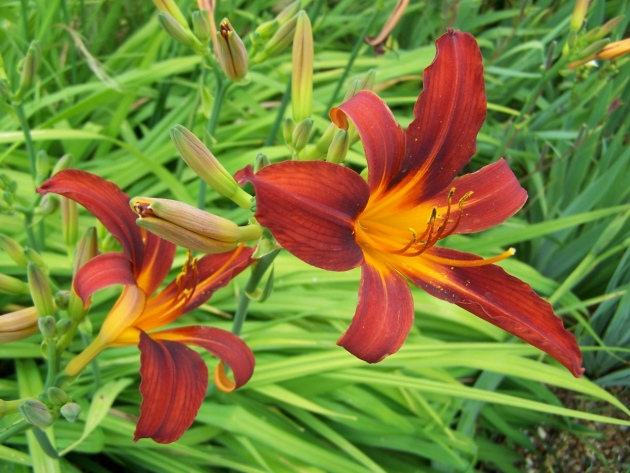
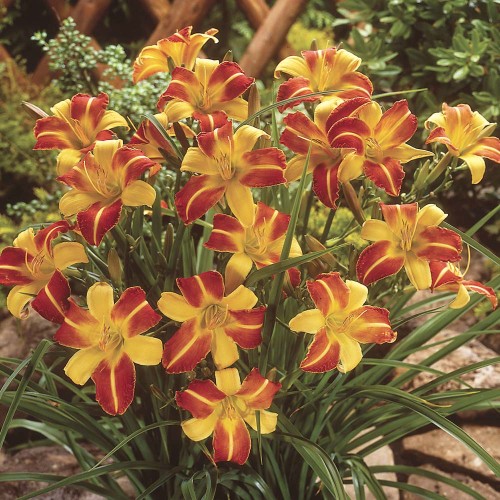
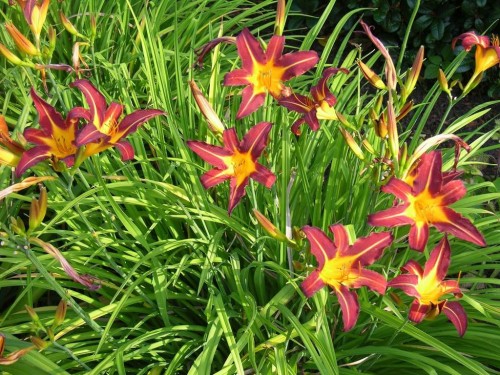
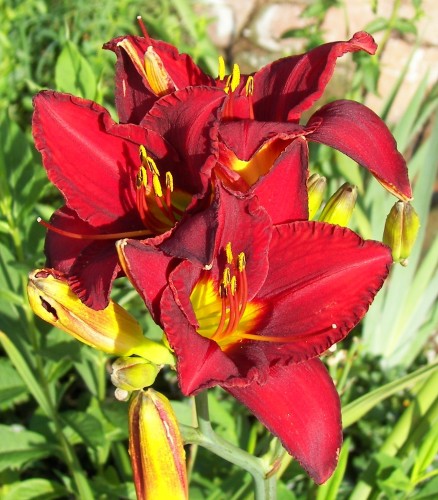
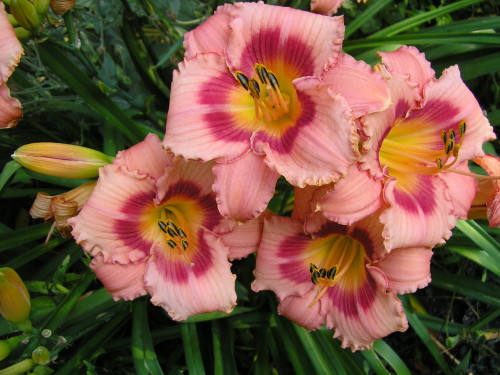
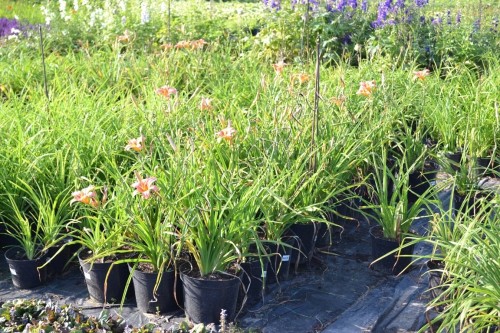
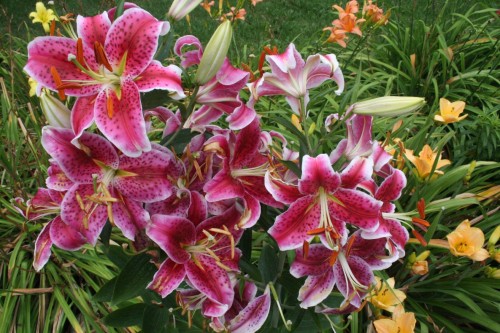
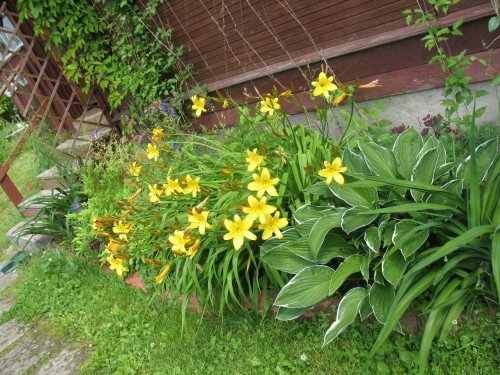
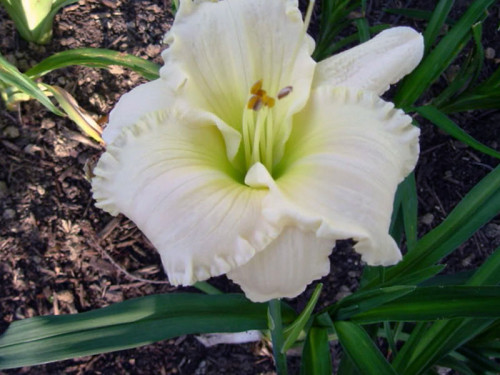












 Start a discussion ...
Start a discussion ...